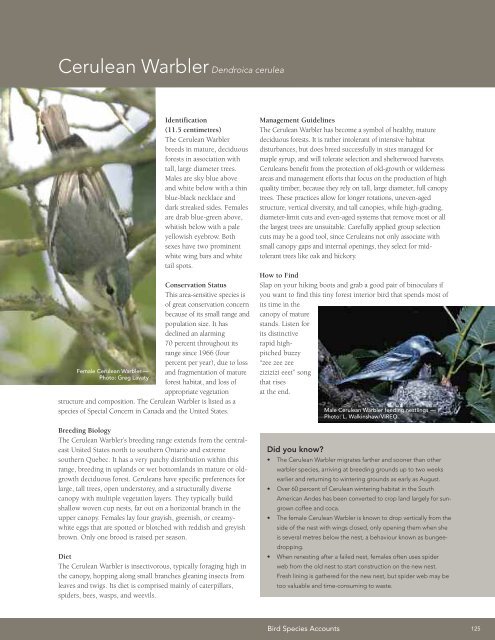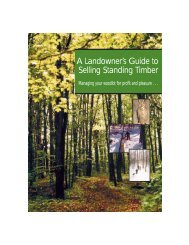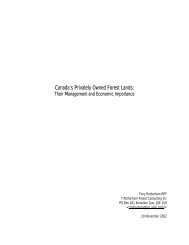A land manager's guide to conserving habitat for forest birds in ...
A land manager's guide to conserving habitat for forest birds in ...
A land manager's guide to conserving habitat for forest birds in ...
You also want an ePaper? Increase the reach of your titles
YUMPU automatically turns print PDFs into web optimized ePapers that Google loves.
Cerulean Warbler Dendroica cerulea<br />
Female Cerulean Warbler —<br />
Pho<strong>to</strong>: Greg Lavaty<br />
Identification<br />
(11.5 centimetres)<br />
The Cerulean Warbler<br />
breeds <strong>in</strong> mature, deciduous<br />
<strong>for</strong>ests <strong>in</strong> association with<br />
tall, large diameter trees.<br />
Males are sky blue above<br />
and white below with a th<strong>in</strong><br />
blue-black necklace and<br />
dark streaked sides. Females<br />
are drab blue-green above,<br />
whitish below with a pale<br />
yellowish eyebrow. Both<br />
sexes have two prom<strong>in</strong>ent<br />
white w<strong>in</strong>g bars and white<br />
tail spots.<br />
Conservation Status<br />
This area-sensitive species is<br />
of great conservation concern<br />
because of its small range and<br />
population size. It has<br />
decl<strong>in</strong>ed an alarm<strong>in</strong>g<br />
70 percent throughout its<br />
range s<strong>in</strong>ce 1966 (four<br />
percent per year), due <strong>to</strong> loss<br />
and fragmentation of mature<br />
<strong>for</strong>est <strong>habitat</strong>, and loss of<br />
appropriate vegetation<br />
structure and composition. The Cerulean Warbler is listed as a<br />
species of Special Concern <strong>in</strong> Canada and the United States.<br />
Breed<strong>in</strong>g Biology<br />
The Cerulean Warbler’s breed<strong>in</strong>g range extends from the centraleast<br />
United States north <strong>to</strong> southern Ontario and extreme<br />
southern Quebec. It has a very patchy distribution with<strong>in</strong> this<br />
range, breed<strong>in</strong>g <strong>in</strong> up<strong>land</strong>s or wet bot<strong>to</strong>m<strong>land</strong>s <strong>in</strong> mature or oldgrowth<br />
deciduous <strong>for</strong>est. Ceruleans have specific preferences <strong>for</strong><br />
large, tall trees, open unders<strong>to</strong>rey, and a structurally diverse<br />
canopy with multiple vegetation layers. They typically build<br />
shallow woven cup nests, far out on a horizontal branch <strong>in</strong> the<br />
upper canopy. Females lay four grayish, greenish, or creamywhite<br />
eggs that are spotted or blotched with reddish and greyish<br />
brown. Only one brood is raised per season.<br />
Diet<br />
The Cerulean Warbler is <strong>in</strong>sectivorous, typically <strong>for</strong>ag<strong>in</strong>g high <strong>in</strong><br />
the canopy, hopp<strong>in</strong>g along small branches glean<strong>in</strong>g <strong>in</strong>sects from<br />
leaves and twigs. Its diet is comprised ma<strong>in</strong>ly of caterpillars,<br />
spiders, bees, wasps, and weevils.<br />
Management Guidel<strong>in</strong>es<br />
The Cerulean Warbler has become a symbol of healthy, mature<br />
deciduous <strong>for</strong>ests. It is rather <strong>in</strong><strong>to</strong>lerant of <strong>in</strong>tensive <strong>habitat</strong><br />
disturbances, but does breed successfully <strong>in</strong> sites managed <strong>for</strong><br />
maple syrup, and will <strong>to</strong>lerate selection and shelterwood harvests.<br />
Ceruleans benefit from the protection of old-growth or wilderness<br />
areas and management ef<strong>for</strong>ts that focus on the production of high<br />
quality timber, because they rely on tall, large diameter, full canopy<br />
trees. These practices allow <strong>for</strong> longer rotations, uneven-aged<br />
structure, vertical diversity, and tall canopies, while high-grad<strong>in</strong>g,<br />
diameter-limit cuts and even-aged systems that remove most or all<br />
the largest trees are unsuitable. Carefully applied group selection<br />
cuts may be a good <strong>to</strong>ol, s<strong>in</strong>ce Ceruleans not only associate with<br />
small canopy gaps and <strong>in</strong>ternal open<strong>in</strong>gs, they select <strong>for</strong> mid<strong>to</strong>lerant<br />
trees like oak and hickory.<br />
How <strong>to</strong> F<strong>in</strong>d<br />
Slap on your hik<strong>in</strong>g boots and grab a good pair of b<strong>in</strong>oculars if<br />
you want <strong>to</strong> f<strong>in</strong>d this t<strong>in</strong>y <strong>for</strong>est <strong>in</strong>terior bird that spends most of<br />
its time <strong>in</strong> the<br />
canopy of mature<br />
stands. Listen <strong>for</strong><br />
its dist<strong>in</strong>ctive<br />
rapid highpitched<br />
buzzy<br />
“zee zee zee<br />
zizizizi eeet” song<br />
that rises<br />
at the end.<br />
Did you know?<br />
Male Cerulean Warbler feed<strong>in</strong>g nestl<strong>in</strong>gs —<br />
Pho<strong>to</strong>: L. Walk<strong>in</strong>shaw/VIREO<br />
• The Cerulean Warbler migrates farther and sooner than other<br />
warbler species, arriv<strong>in</strong>g at breed<strong>in</strong>g grounds up <strong>to</strong> two weeks<br />
earlier and return<strong>in</strong>g <strong>to</strong> w<strong>in</strong>ter<strong>in</strong>g grounds as early as August.<br />
• Over 60 percent of Cerulean w<strong>in</strong>ter<strong>in</strong>g <strong>habitat</strong> <strong>in</strong> the South<br />
American Andes has been converted <strong>to</strong> crop <strong>land</strong> largely <strong>for</strong> sungrown<br />
coffee and coca.<br />
• The female Cerulean Warbler is known <strong>to</strong> drop vertically from the<br />
side of the nest with w<strong>in</strong>gs closed, only open<strong>in</strong>g them when she<br />
is several metres below the nest, a behaviour known as bungeedropp<strong>in</strong>g.<br />
• When renest<strong>in</strong>g after a failed nest, females often uses spider<br />
web from the old nest <strong>to</strong> start construction on the new nest.<br />
Fresh l<strong>in</strong><strong>in</strong>g is gathered <strong>for</strong> the new nest, but spider web may be<br />
<strong>to</strong>o valuable and time-consum<strong>in</strong>g <strong>to</strong> waste.<br />
Bird Species Accounts 125

















